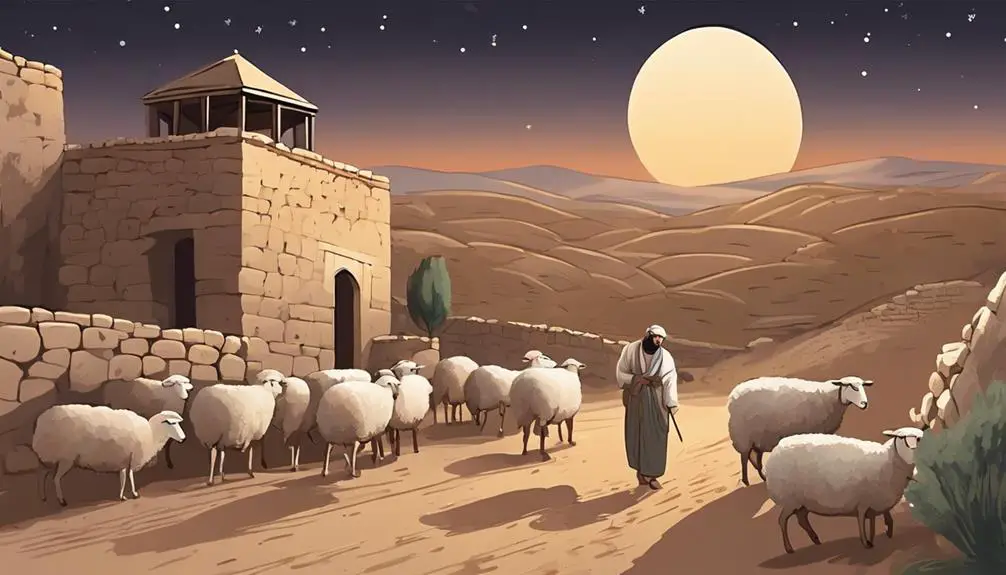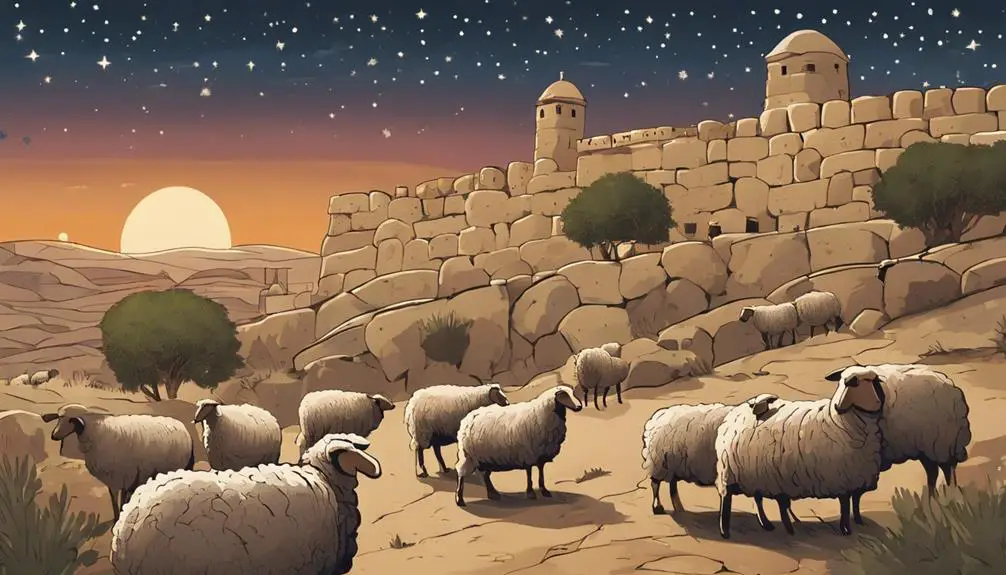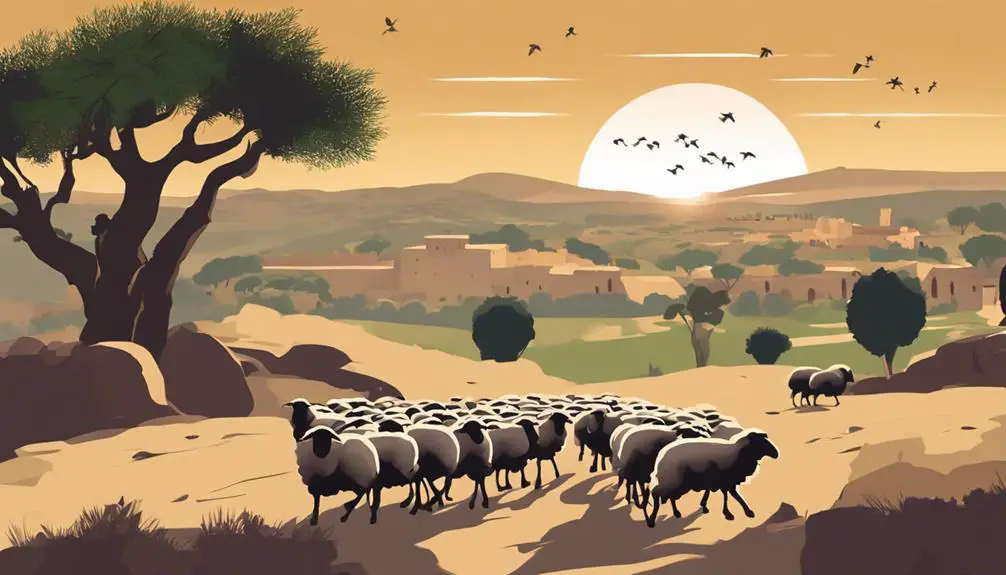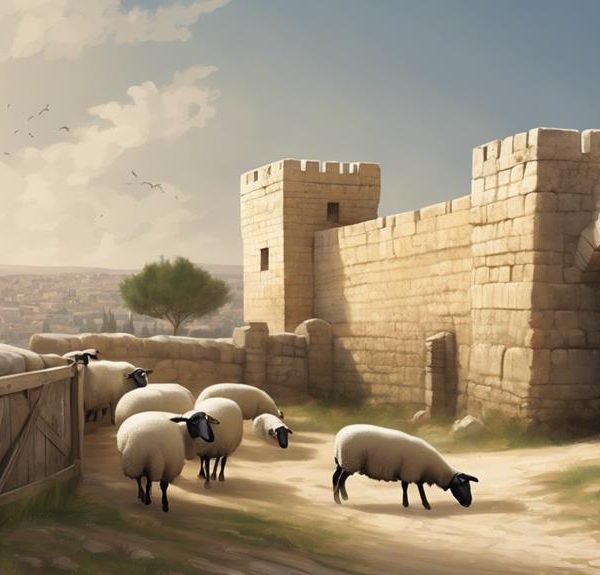Discover the ancient symbolism of a biblical sheepfold, where protection and spirituality converge, inviting you to explore its deeper meanings.

What Is a Sheepfold in the Bible
In the Bible, a sheepfold isn't just a simple enclosure for livestock; it's a sanctuary of security juxtaposed against the perilous wilderness outside its bounds. You'll find that this ancient structure serves not only a practical purpose but also embodies profound spiritual symbolism.
The scriptures weave a narrative where the sheepfold and its shepherd emerge as central figures, illustrating themes of protection, guidance, and belonging. As you explore the historical context and the layered meanings behind the sheepfold, you'll uncover insights that resonate with modern interpretations and applications.
This journey into biblical symbolism invites you to ponder deeper connections between the text and its implications for faith and life today.
Key Takeaways
- A sheepfold in the Bible symbolizes security and sustenance, providing protection for the flock from predators and theft.
- It reflects spiritual safety, belonging, and protection, transcending literal boundaries to embody a sanctuary for the community.
- The shepherd's role, deeply connected with the sheepfold, symbolizes leadership, guidance, and care for each member of the flock.
- Sheepfolds and their management offer lessons on leadership, community support, and the importance of spiritual safety in contemporary contexts.
Historical Context of Sheepfolds

Understanding the historical context of sheepfolds is crucial to comprehending their multifaceted role in biblical times. Delving into the ancient construction of these structures, you'll find they were more than mere physical spaces for livestock. They symbolized security and sustenance within a pastoral nomadic lifestyle, which was predominant in the Near East.
The essence of pastoral nomadism, a way of life centered around the herding of sheep and goats, necessitated the development of sheepfolds. These weren't haphazard constructions but carefully thought-out enclosures, built using available materials such as stones or branches, designed to protect the flock from predators and theft. This ancient construction technique reflects a deep understanding of the landscape and resource management, showcasing the ingenuity of early pastoralists.
Moreover, the strategic placement of sheepfolds within grazing routes underscores their importance in pastoral nomadism. It allowed for the rotation of grazing areas, preventing overuse and ensuring the sustainability of the lifestyle. This careful balance between the needs of the flock and the environment highlights the intricate relationship between ancient peoples and their land, a testament to their resilience and adaptability.
Biblical References to Sheepfolds

Moving from the historical construction and significance of sheepfolds, let's examine how these structures are woven into the fabric of biblical narratives, serving both literal and metaphorical roles. In the biblical context, sheepfold construction isn't merely a backdrop for pastoral scenes; it's a critical element that provides night protection for the flock, safeguarding them from predators and theft.
- John 10:1-18 delves into the importance of the sheepfold, highlighting its protective role and the shepherd's duty to guard the entrance, ensuring the safety of the sheep inside. This passage emphasizes the necessity of a secure enclosure for the sheep's overnight protection.
- 1 Samuel 24:3 mentions sheepfolds in the context of King Saul's pursuit of David, illustrating their commonplace presence in the landscape and their utility not just for sheep but occasionally for humans seeking shelter or hiding.
- 2 Chronicles 32:28-29 references the construction of sheepfolds as part of Hezekiah's broader agricultural and economic reforms, underscoring the sheepfold's significance in the socioeconomic fabric of ancient Israelite society.
These references illuminate the multifaceted role of sheepfolds in biblical times, blending practicality with deeper spiritual and communal significance.
Symbolism of the Sheepfold

In biblical narratives, the sheepfold often symbolizes spiritual safety and communal belonging, reflecting a profound theological depth beyond its physical structure. This pastoral imagery isn't merely decorative but serves a pivotal role in conveying messages of protection and collective identity. You'll find that the concept of a sheepfold transcends its literal confines to embody a sanctuary where the faithful are safeguarded from spiritual peril.
The emphasis on flock safety within this imagery is paramount. It's not just about physical protection but also about the preservation of a community's faith and morals in the face of external threats. This symbolism resonates deeply with the pastoral care model, where guidance and nurture are essential for maintaining the integrity of the community.
Analyzing the sheepfold's symbolism, it's clear that it's a multifaceted representation of how a community navigates its spiritual journey. It's about creating a space where individuals, despite their vulnerabilities, find strength in their collective identity and faith. Thus, the sheepfold stands as a testament to the enduring nature of communal support and spiritual fortitude in biblical literature.
The Shepherd and His Flock

Central to biblical narratives is the role of the shepherd, who symbolizes leadership, guidance, and the deep, personal care afforded to each member of the flock. This relationship between the shepherd and his flock is multifaceted, drawing on the intricate dynamics of pastoral care and leadership. As you delve deeper into the shepherd's role, you encounter a rich tapestry of responsibilities that extend beyond mere oversight.
The shepherd's intimate knowledge of grazing patterns and flock dynamics becomes a metaphor for spiritual guidance and community leadership. This knowledge isn't superficial; it's borne of a deep connection and understanding of the needs and behaviors of the flock. Consider the following aspects:
- Grazing Patterns: The shepherd ensures that the flock accesses the best pastures, symbolizing the guidance towards nourishing spiritual and moral pastures.
- Flock Dynamics: Understanding individual and collective behaviors within the flock mirrors the shepherd's insight into human nature and community needs.
- Protection and Care: Beyond physical safety, the shepherd's role encompasses the emotional and spiritual welfare of the flock, reflecting a holistic approach to leadership.
This analytical perspective underscores the shepherd's role as not just a caretaker but as a pivotal figure in fostering community, spirituality, and moral guidance.
Modern Interpretations and Applications

As we explore modern interpretations and applications, it's crucial to understand how the timeless role of the shepherd has evolved to offer insight into contemporary leadership and spiritual guidance. In today's rapidly urbanizing world, the metaphor of the shepherd and the sheepfold resonates deeply with concepts of urban spirituality. This perspective encourages you to navigate the complexities of city life with a shepherd's attentiveness and care, fostering communities that are inclusive and supportive.
Moreover, the shepherd's role in guiding and protecting the flock lends itself to a broader interpretation of ecological stewardship. You're called to act as guardians of the environment, managing resources wisely and ensuring the sustainability of our planet for future generations. This modern application challenges you to balance development with the preservation of natural habitats, mirroring the shepherd's balance of leading the flock and caring for the land.
In this context, the biblical sheepfold transforms into a symbol of collective responsibility and ethical leadership. It invites you to consider how ancient wisdom can inform and inspire efforts to address contemporary challenges, promoting a harmonious coexistence between urban development and ecological preservation.
Frequently Asked Questions
How Did Ancient Sheepfolds Differ in Construction and Materials Across Various Regions Mentioned in the Bible?
You'll find that ancient sheepfolds varied greatly in construction and materials across different regions mentioned in the Bible, primarily due to climate impact and architectural evolution.
The materials ranged from stone in arid areas to wood in more forested landscapes. Each region's approach reflected its unique environmental challenges and available resources, showcasing a fascinating blend of practicality and ingenuity in ensuring the safety and management of sheep herds throughout biblical times.
What Role Did Sheepfolds Play in the Economic and Social Life of Biblical Communities Beyond Their Agricultural Use?
Beyond their practical use, sheepfolds held significant weight in the economic and social spheres. They weren't just for agriculture; they were hubs of community gatherings, fostering social cohesion.
Moreover, sheepfolds carried deep religious symbolism, intertwining everyday life with spiritual beliefs. This dual role underscored their importance, serving not only as a means of livelihood but also as centers for religious and communal activities, reflecting the intertwined nature of daily and spiritual life.
Are There Any Specific Rituals or Ceremonies in the Bible That Were Performed in or Around Sheepfolds?
In exploring rituals or ceremonies linked to sheepfolds, you'll find no explicit biblical references to specific rites conducted within these enclosures.
However, considering the broader context of ritual symbolism and ceremonial purity in the Bible, it's plausible that sheepfolds, as places of animal keeping, might indirectly relate to practices of sacrifice and purification.
These ceremonies often required unblemished animals, a criterion possibly ensured within the controlled environment of a sheepfold.
How Do Contemporary Shepherds in the Geographic Areas Mentioned in the Bible Maintain the Tradition of Sheepfolding, and What Modern Adaptations Have Been Made?
You're exploring how contemporary shepherds maintain sheepfolding traditions while integrating modern adaptations. Advances in sheep breeding and technological tools are pivotal.
These shepherds skillfully blend ancient practices with cutting-edge technologies, ensuring the sustainability and efficiency of their herds. From enhanced breeding techniques to the use of drones for monitoring, the evolution of sheepfolding reflects a deep respect for tradition, paired with an eye toward innovation and environmental stewardship.
In Biblical Narratives, Are There Any Mentions of Notable Figures or Events That Took Place in a Sheepfold That Are Not Directly Related to Shepherding or Agriculture?
You're exploring how, beyond its practical use, sheepfolds in biblical stories often carry symbolic meanings or architectural symbolism unrelated to shepherding or agriculture.
These narratives weave complex layers of meaning, where locations like sheepfolds aren't just physical settings but embody deeper spiritual or moral lessons.
Analyzing these instances reveals how biblical authors used everyday elements to communicate profound truths, showing that the significance of a sheepfold extends far beyond its walls.
Conclusion
In conclusion, you've explored the multifaceted significance of sheepfolds within the biblical narrative, ranging from their historical context to their rich symbolic layers.
You've seen how sheepfolds aren't just physical structures but potent symbols of safety, community, and divine protection.
Through the lens of the shepherd-flock relationship, you've uncovered deeper spiritual insights, illustrating how these ancient references continue to hold profound relevance in modern spiritual discourse.
This exploration has underscored the enduring power of biblical metaphors to convey complex theological truths.



Sign up